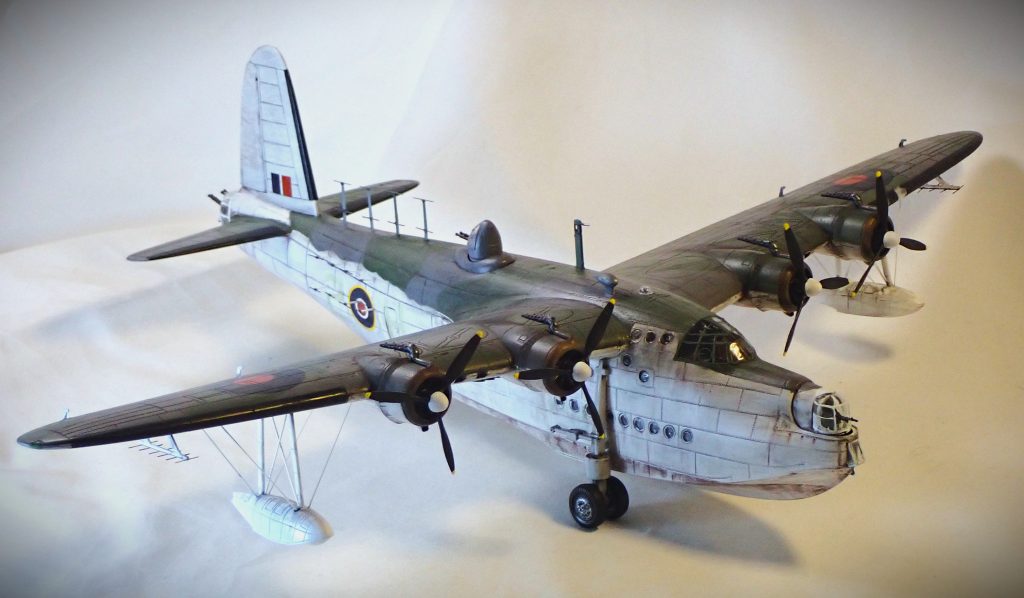The Short Brothers developed a flying boat airliner the S.23 Empire in the early thirties for Imperial Airways. Running parallel to the project was a militarised version under the requirement of the Air Ministry to develop a long-range reconnaissance/patrol flying boat for the RAF. The result was the Short S.25 Sunderland, named after the city in the NE of England, a four-engine flying boat patrol bomber. Although similar in structure to the Empire, the Sunderland had a deeper hull and was armed with defensive gun turrets and ASV II radar and could carry bombs, depth charges and aerial mines. It was primarily designed for anti-submarine/recon patrol but served in the air sea rescue role admirably. The prototype Sunderland first flew in 1937 and the first production model in April 1938 becoming operational in June that year.
The Sunderland was a large aircraft with a crew of 9 usually or this could be increased to 11 for long-range ops. It was originally powered by four Bristol Pegasus XXII 9-cylinder radial piston engines each with an output of 1,010hp. Internally the aircraft had two decks with cockpit, munitions room, turrets and flight control on the top deck with a galley, wardroom, bunks, porcelain toilet, stores and machine room, compartmentalised with watertight swash doors. The front turret could be winched back into the fuselage to reveal a small deck for mooring purposes. The wings were very thick to house the engine nacelles and six large fuel tanks with four more small tanks added from the Mk.II giving it capacity of 2,500 gallons, enough for up to 14 hours patrol if required. The Mk.I was armed with two fully powered turrets with five .303 Browning and two open hatches with removable Lewis K guns mid-dorsal. Crews were required to be familiar with boat operations for taxiing and mooring. Although they were moored when not operational ground crews could attach double wheeled portable struts which attached to the fuselage under each wing with a trolley under the aft hull for beaching or towing onto land during rough seas. Engine maintenance was usually performed at mooring with a large platform being attached under the cowling via fixings in the wing leading edge.
At the outbreak of WW2 there were 40 operational Sunderlands with RAF Coastal Command. No.230 Squadron was the first to receive the type in Singapore in 1938 with a further 15 squadrons being equipped by 1942. A total of 777 Sunderlands were built in five versions. The Mk.II upgraded the engines to Pegasus XVIII and installed an additional twin Browning turret off-set on the mid-dorsal. The addition of ASV II radar (Air-to-Surface Vessel) in 1941 gave it a vast advantage in anti-submarine warfare. The appearance of four tall antenna on the rear dorsal and eight smaller antennas either side with a receiver on each wing outboard of the float earned it the nickname “Flying Porcupine”. The Mk.III was the definitive with 461 being built. One major alteration was the curved hull step to give a smoother take-off and better seaworthiness. The Mk.III was a major opponent for the U-boat scourge. From early 1943 improved ASV III radar and more machine guns were fitted as well as the addition of new hydrostatic depth charges. The Mk.V was the last production model with 155 built including heavier armament in the .50 Brownings, improved radar in blisters and American engines, Pratt & Whitney R-1830 twin Wasp, giving more power and better performance. A Mk.IV had been developed but due to the differences in fuselage and wing upgrades the Mk.IV was redesignated the Short Seaford. Although 60 were ordered it was never finished in time to see action.
The Sunderland was used by many other Commonwealth and overseas countries during the war with principal operators being Australia, France, New Zealand and Canada. Smaller numbers were in service with Portugal, Norway and South Africa. In 1942 BOAC acquired six Sunderland Mk.III for mail, freight and passenger services from Poole in Dorset to Lagos and Calcutta. These aircraft were stripped of all military fixings during production. Six more were added in 1943 with another four going to New Zealand for services on the south Pacific island routes. The Sunderland flew with RAF Coastal Command for the duration of the war and was responsible for the rescue of many downed pilots, especially during the Battle of Britain and operations in the Med, as well as disabling many U-boats. After the war a great many Sunderlands were converted for civilian use and procured by many commercial operators worldwide including BOAC, Qantas and Ansett.
There are few survivors today, seven all up. Three in New Zealand, two in America, one of which is allegedly airworthy, and two in the UK.
ML796 at the IWM, Duxford
ML824 at the RAF Museum, Hendon which visitors can walk through the interior of the aircraft.
